I am likely to do as little work as I can get away with through the winter (and certainly most gardening chores can be delayed unless some catastrophe strikes), but these months drag on far too long. At some point there will be a few bright, sunny days when I’m anxious to get out, until I feel a chilly breeze, and then plans to clean up some clutter or cut back the tops of perennials vanish quickly. Even if temperatures turn unusually warm, it’s difficult for me to break loose the rust and get the old joints moving. I’ve planned for weeks to cut back the old foliage of hellebores (below) so that the February flowers can be seen more readily, but I haven’t gotten around to it, and probably won’t until the blooms are out.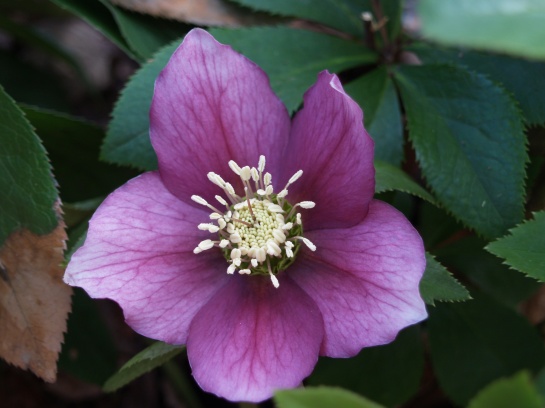
Still, even on a gray, blustery afternoon there are reasons to get out into the garden. With little effort, the gardener can select a handful of sturdy shrubs, perennials, and bulbs so that there are blooms throughout the winter months, and these are particularly welcome when the garden is almost completely dormant. I particularly enjoy woody shrubs that provide blooms for extended periods.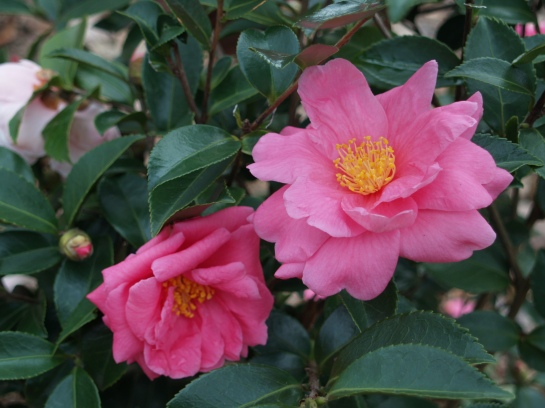
As late autumn begins to feel the oncoming winter chill, cold hardy hybrid camellias (Camellia x ‘Winter’s Joy’, above) begin to flower. Some will bloom through November, but often there are buds that will open during a brief spell of warm temperatures in December or January. In my northwestern Virginia garden the delicate flowers rarely last longer than a few days before the edges are damaged and turn brown due to frost or freeze, but how delightful these are, even for such a short period.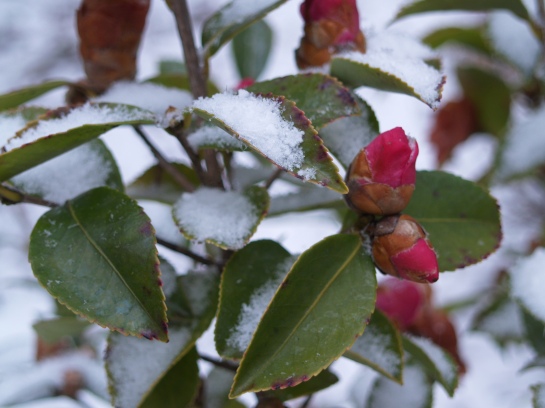
Several camellias in my garden that are more shaded barely flowered at all in November, so they’re loaded with fat buds that show a tiny peek of pink (above). With a day or two of not so cold temperatures the buds swell slightly, but they are unlikely to open fully without several warm days in succession. I expect that many of the buds will eventually be damaged by cold and will not result in flowers, but I’m hoping for a few blooms before the winter is through.
By mid November the ‘Winter Sun’ mahonias (Mahonia x media ‘Winter Sun’, above) begin to flower, and the bright yellow blooms are bothered only slightly by cold, so they will often persist into January. On a warm winter afternoon a few honeybees (below) might find their way to take their fill of nectar from the sweetly scented flowers. By early January the spring flowering leatherleaf mahonias (Mahonia bealei) begin to show a hint of yellow, so with full bloom not expected until mid March there will be flowers on one mahonia or the other from November through March.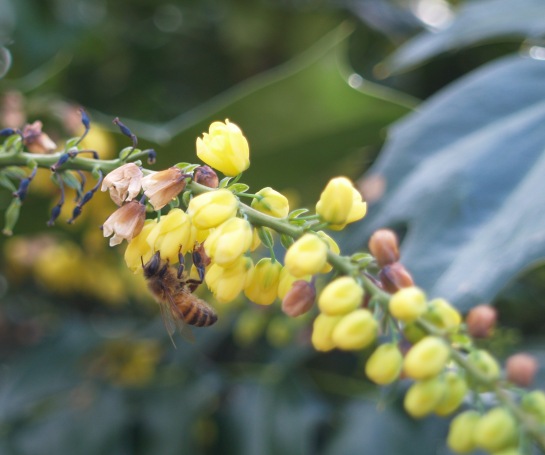
I prefer the densely branched, upright form of ‘Winter Sun’ rather than the sprawling habit of leatherleaf mahonia, but I’ve planted a handful of each for their winter blooms. A few of the leatherleaf mahonias have grown from seed deposited about the garden by birds that have consumed the small, grape-like berries that follow the flowers in early spring. Unwanted seedlings are easily removed, but a few at the forest’s edge have been encouraged.
The mahonias are sturdy and low care evergreens that are not bothered by pests, including deer, though I’ve heard reports that they will nibble the flowers. I’ve not seen that in my garden, where deer steer clear of the sharply spined foliage. I’ve planted mahonias in both sun and part shade, and flowering and growth are more vigorous with more sun. A recent mahonia introduction, ‘Soft Caress’ (Mahonia eurybracteata ‘Soft Caress’, above) flowers in mid autumn, but is only marginally cold hardy in my garden, so it falters enough in the winter months that it should be planted only in a protected spot in mid Atlantic gardens.
By late December the small ribbon-like flowers of Vernal witch hazel (Hamamelis vernalis, above) become evident, and through January the highly fragrant blooms will fill the lower garden with their scent. The flowers are not nearly as ornamental as the brightly colored blooms of the hybrid witch hazels, but on a stroll through the garden on the coldest days of winter, the flowers are greatly appreciated.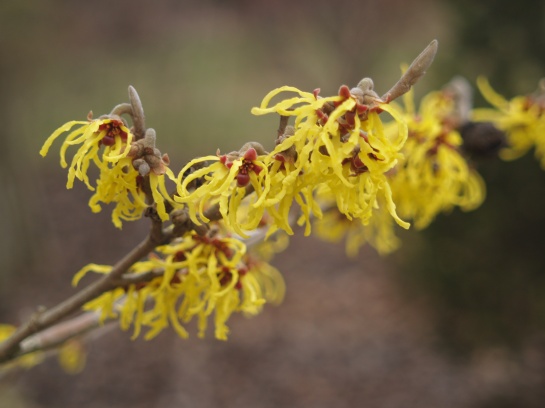
The flowers of the hybrid witch hazels are larger, much more colorful than the Vernal witch hazel, and just as fragrant. The bright yellow flowers of ‘Arnold Promise’ (Hamamelis x intermedia ‘Arnold Promise, above) are at least the equal to the blooms of forsythia, but they flower a month earlier and are more fragrant. The red ‘Diane’ and copper ‘Jelena’ flower more sparsely for me in part shade, but these are wonderful large shrubs in well drained soils.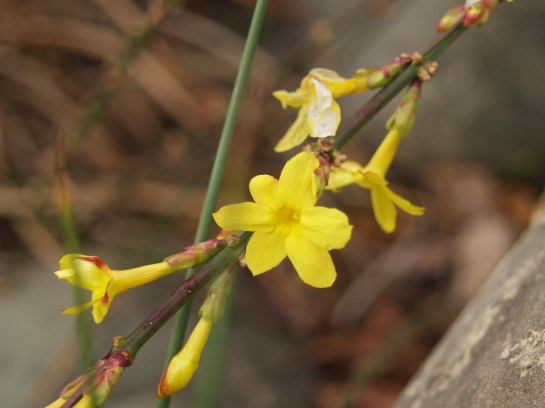
Along one side of the large koi pond, the branches of Winter jasmine (Jasminum nudiflorum, above) cascade over boulders to the water’s edge. Beginning in late December (and certainly by mid January, though they are late this year) the arching stems are covered by yellow forsythia-like flowers, and like forsythia, Winter jasmine is nearly indestructible. The stems root wherever they contact soil, so winter jasmine is effective for retaining soil on slopes, but in this garden it serves only to improve the gardener’s disposition through the winter months.
Wonderful! I love the mahonias!
I’ve looked to add other varieties of mahonia to my garden, but the flowers and foliage of others are not as attractive as on Winter Sun and leatherleaf.
Prunus mume and WinterSweet are on my list this year to add for Winter color and scent!
I’m considering Chimonanthus, but with limited space I have to be choosy about adding shrubs. More trees are out of the question, at least for now. I checked on the Persian witch hazel (Parrotia persica) yesterday, and it looks like it’s going to be covered in blooms this winter. Last year there were only a few, so I’m enthused about that.